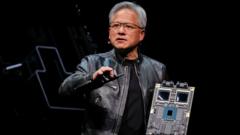As President Xi Jinping grapples with the economic strain from Donald Trump’s tariffs, he must also confront a fragile domestic market, an aging population, and fears about employment, all while attempting to fulfill his promises of prosperity within China.
Xi Jinping's Economic Challenges: Navigating Tariffs and Domestic Struggles

Xi Jinping's Economic Challenges: Navigating Tariffs and Domestic Struggles
Amid rising tariffs, Chinese President Xi Jinping faces significant domestic economic challenges that threaten his vision of a rejuvenated China.
China's economic landscape is undergoing a tumultuous transformation as President Xi Jinping faces a dual challenge from both external pressures, particularly tariffs imposed by former U.S. President Donald Trump, and significant internal economic struggles. While Trump's policies provoke mockery among Chinese traders, inspiring a wave of memes and nationalist sentiments, the looming economic pressures within China speak to a deeper malaise that Xi's dream of resurgence is struggling to uphold.
In recent statements, Xi has reaffirmed the country’s trajectory of self-reliance, claiming China has always drawn from its own resources rather than foreign aid. As a result, the nation has become less reliant on U.S. exports compared to a decade ago. Nevertheless, the impact of Trump's tariffs comes at a sensitive time as China's economy grapples with a stagnant housing market, rising job insecurity, and an aging demographic unable to bolster consumer spending.
The real test of Xi's governance began more than a decade ago, promising economic prosperity for China's vast population of 1.4 billion. Instead, a housing crisis has left many citizens disenchanted, as investments in real estate now appear less viable, with thousands of properties lying unoccupied. Reports estimate vacant homes could accommodate up to three billion people, prompting concerns about consumer confidence.
Young Chinese workers are particularly affected, as they face the highest unemployment rates in urban areas, with over 20% of 16 to 24-year-olds jobless in mid-2023. Meanwhile, fears of inadequate pension provisions loom as a demographic shift will see millions leaving the workforce over the next decade. The situation demands urgent reforms to boost disposable income and encourage domestic spending, yet analysts caution that such a transition will require substantial time and effort.
To address these domestic hurdles, Xi's government has attempted to stimulate the economy through subsidies, wage increases, and consumer discounts; however, critics remain skeptical about the sustained impact of these measures. Evidence of growing public discontent manifests in rising protests centered on financial grievances, although the government swiftly suppresses dissent.
In a bid to counter the damaging effects of Trump's tariffs, Xi is shifting towards diversifying trade partnerships, with a focus on strengthening ties within Southeast Asia, Latin America, and Africa. Despite these efforts, challenges persist, and neighboring countries remain wary of a flood of cheap exports that could disrupt their local economies, leading to competitive tensions.
While Xi’s ambitions for technological supremacy face hurdles from U.S. restrictions on semiconductor exports, there is a glimmer of hope in the domestic market. With an eye on long-term strategies, Xi seems poised to navigate through this storm, leveraging the current economic climate to rethink China's role in global trade.
As Xi positions China as a stable trade alternative to the U.S., the onus remains on him and his government to enact policies that genuinely enhance the economic prospects of ordinary Chinese citizens. With Trump suggesting a potential softening of his tariff stance, the battle between these titans may have more significant implications for both nations' economies than previously perceived, pushing Xi to address the glaring issues within his country's borders.
In recent statements, Xi has reaffirmed the country’s trajectory of self-reliance, claiming China has always drawn from its own resources rather than foreign aid. As a result, the nation has become less reliant on U.S. exports compared to a decade ago. Nevertheless, the impact of Trump's tariffs comes at a sensitive time as China's economy grapples with a stagnant housing market, rising job insecurity, and an aging demographic unable to bolster consumer spending.
The real test of Xi's governance began more than a decade ago, promising economic prosperity for China's vast population of 1.4 billion. Instead, a housing crisis has left many citizens disenchanted, as investments in real estate now appear less viable, with thousands of properties lying unoccupied. Reports estimate vacant homes could accommodate up to three billion people, prompting concerns about consumer confidence.
Young Chinese workers are particularly affected, as they face the highest unemployment rates in urban areas, with over 20% of 16 to 24-year-olds jobless in mid-2023. Meanwhile, fears of inadequate pension provisions loom as a demographic shift will see millions leaving the workforce over the next decade. The situation demands urgent reforms to boost disposable income and encourage domestic spending, yet analysts caution that such a transition will require substantial time and effort.
To address these domestic hurdles, Xi's government has attempted to stimulate the economy through subsidies, wage increases, and consumer discounts; however, critics remain skeptical about the sustained impact of these measures. Evidence of growing public discontent manifests in rising protests centered on financial grievances, although the government swiftly suppresses dissent.
In a bid to counter the damaging effects of Trump's tariffs, Xi is shifting towards diversifying trade partnerships, with a focus on strengthening ties within Southeast Asia, Latin America, and Africa. Despite these efforts, challenges persist, and neighboring countries remain wary of a flood of cheap exports that could disrupt their local economies, leading to competitive tensions.
While Xi’s ambitions for technological supremacy face hurdles from U.S. restrictions on semiconductor exports, there is a glimmer of hope in the domestic market. With an eye on long-term strategies, Xi seems poised to navigate through this storm, leveraging the current economic climate to rethink China's role in global trade.
As Xi positions China as a stable trade alternative to the U.S., the onus remains on him and his government to enact policies that genuinely enhance the economic prospects of ordinary Chinese citizens. With Trump suggesting a potential softening of his tariff stance, the battle between these titans may have more significant implications for both nations' economies than previously perceived, pushing Xi to address the glaring issues within his country's borders.


















